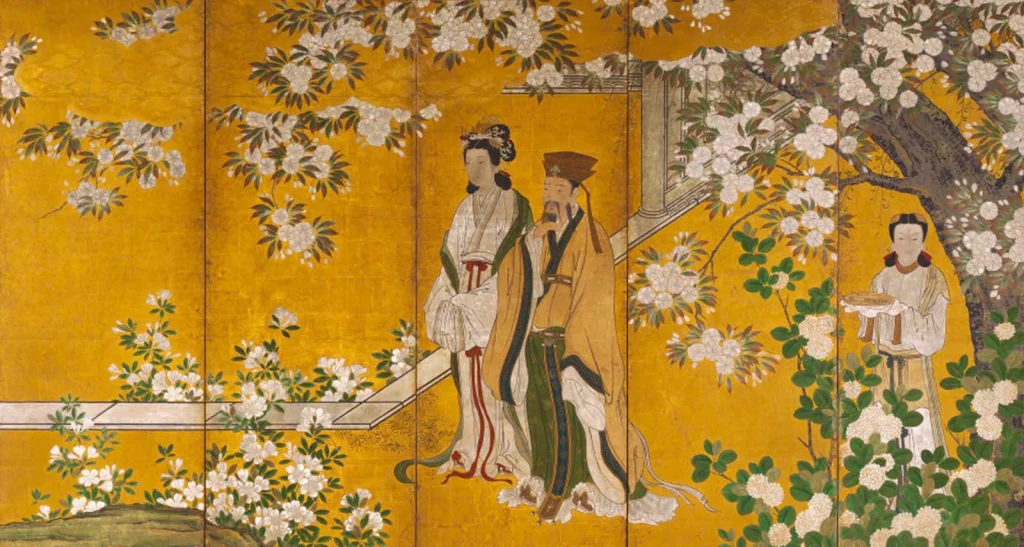赏析
元稹的这首《行宫》是一首抒发盛衰之感的诗,这首短小精悍的五绝具有深邃的意境,富有隽永的诗味,倾诉了宫女无穷的哀怨之情,寄托了诗人深沉的盛衰之感。
诗人先写环境。首句中“寥落”已点出行宫的空虚冷落,又着一“古”字,更显其破旧之象。这样的环境本身就暗示着昔盛今衰的变迁。而后以“宫花寂寞红”续接,此处可见运思缜密。娇艳红花与古旧行宫相映衬,更见行宫“寥落”,加强了时移世迁的盛衰之感。两句景语,令人心无旁骛,只有沉沉的感伤。
后两句由景及人,写宫女,“白头”与第二句中的红花相映衬。宫中花开如旧,而当年花容月貌的宫女已变成了白发老妇。物是人非,此间包含着多少哀怨、多少凄凉便不言而喻了。末句“闲”字与上文“寂寞”相照应,写出宫女们长年受冷落的孤寂与无奈。过去她们的一颦一笑、盛装丽服只为取悦君王,而今再无缘见龙颜,她们还能做什么呢? 只能无聊地“闲”在冷宫。而这些宫女们所谈的仍旧是玄宗盛世。这一方面表现了她们对往昔生活的追忆,另方面也证明了如今无可言说的空虚。比较之下,那种深沉的盛衰之感越发鲜明突出而具体了。
这里,寥落古行宫中的白头宫女,还是唐玄宗时代历史的见证人。唐玄宗在其继位后期,宠幸杨贵妃,终日沉溺在淫乐酒色之中,把政务全部委给奸相李林甫和杨国忠,朝纲紊乱,谄佞当道,终于酿成安史之乱。乱后,玄宗被迫退位,赫赫不可一世的大唐王朝亦从此一蹶不振,日益走向下坡路。白居易在《长恨歌》里曾深致感慨说:“缓歌慢舞凝丝竹,尽日君王看不足。渔阳鼙鼓动地来,惊破霓裳羽衣曲。”四句诗,已形象地概括出玄宗昏愦好色与亡国致乱的历史因由,其讽刺与揭露是十分深刻的。元稹这首短诗当然不可能象白诗那样铺张扬厉,极尽渲染之能事,他只能采取对照、暗示点染等方法,把这一段轰轰烈烈的历史高度浓缩,加以典型化的处理,从而让人回味咀嚼。寥落的古行宫,那在寂寞之中随岁月更替而自生自落的宫花,那红颜的少女变为白发老人,都深深地带有时代盛衰迁移的痕迹。白头宫女亲历开元、天宝之世,本身就是历史的见证人,“闲坐说玄宗”的由治而乱。这本是诗篇主旨所在,也是诗人认为应引以为戒的地方,却以貌似悠闲实则深沉的笔调加以表现,语少意多,有无穷之味。
二十个字,地点、时间、人物、动作,全都表现出来了,构成了一幅非常生动的画面。这个画面触发读者联翩的浮想:宫女们年轻时都是花容月貌,娇姿艳质,这些美丽的宫女被禁闭在这冷落的古行宫中,成日寂寞无聊,看着宫花,花开花落,年复一年,青春消逝,红颜憔悴,白发频添,如此被摧残,往事岂堪重新回顾!然而,她们被幽闭冷宫,与世隔绝,别无话题,却只能回顾天宝时代玄宗遗事,此景此情,令人凄绝。“寥落”、“寂寞”、“闲坐”,既描绘当时的情景,也反映诗人的倾向。凄凉的身世,哀怨的情怀,盛衰的感慨,二十个字描绘出那样生动的画面,表现出那样深刻的思想。这首诗正是运用以少总多的表现手法,语少意足,有无穷味。
另一个表现手法是以乐景写哀情。我国古典诗歌,其所写景物,有时从对立面的角度反衬心理,利用忧思愁苦的心情同良辰美景气氛之间的矛盾,以乐景写哀情,却能收到很好的艺术效果。这首诗也运用了这一手法。诗所要表现的是凄凉哀怨的心境,但却着意描绘红艳的宫花。红花一般是表现热闹场面,烘托欢乐情绪的,但在这里却起了很重要的反衬作用:盛开的红花和寥落的行宫相映衬,加强了时移世迁的盛衰之感;春天的红花和宫女的白发相映衬,表现了红颜易老的人生感慨;红花美景与凄寂心境相映衬,突出了宫女被禁闭的哀怨情绪。红花,在这里起了很大的作用。这都是利用好景致与恶心情的矛盾,来突出中心思想,即王夫之《姜斋诗话》所谓“以乐景写哀”,一倍增其哀。白居易《上阳白发人》“宫莺百啭愁厌闻,梁燕双栖老休妒”,也可以说是以乐写哀。不过白居易的写法直接揭示了乐景写哀情的矛盾,而元稹《行宫》则是以乐景作比较含蓄的反衬,显得更有余味。
这首绝句语言平实,但很有概括力,精警动人,也很含蓄,给人以想象的天地,历史沧桑之感尽在不言之中,寓意深刻,自来评价很高。王建的《宫词》,白居易的《长恨歌》,元稹的《连昌宫词》,都是长达千字左右的宏篇巨制,详尽地描述了唐玄宗时代治乱兴衰的历史过程,感叹兴亡。总结教训,内容广博而深刻。元稹这首小诗总共不过二十个字,能入选《唐诗三百首》,与这些长篇巨作比美,可谓短小精悍,字字珠玑。
appreciation
Yuan Zhen’s Xinggong is a poem expressing the sense of prosperity and decline. This short and pithy five wonders has profound artistic conception and meaningful poetic flavor. It tells the endless sorrow of the palace maids and places the poet’s deep sense of prosperity and decline.
The poet writes about the environment first. In the first sentence, “Liaoluo” has already pointed out the emptiness and coldness of the palace, and the word “ancient” is added, which is more dilapidated. Such environment itself implies the vicissitudes of past prosperity and present decline. Then, “Palace Flower Lonely Red” continues to be used. Here, we can see the meticulous thinking. The charming red flowers contrast with the ancient palaces, and the palaces are “rare”, which strengthens the sense of prosperity and decline when time changes. Two sentences of scenery language can make people concentrate on nothing but deep sadness.
The last two sentences describe the palace maids from the scene to the people. The “white head” and the red flower in the second sentence set off each other. The flowers in the palace are as old as before, and the palace maids with beautiful looks in those days have become old women with white hair. It is self-evident how much sorrow and desolation there are. The word “leisure” in the last sentence corresponds to the word “loneliness” above, which describes the loneliness and helplessness of palace maids who have been neglected for years. In the past, their smiles and costumes were just to please the king, but now they have no chance to see the dragon face. What can they do? Only can be bored “idle” in the cold palace. But what these palace maids talked about was still the prosperous age of Xuanzong. On the one hand, it shows their memories of the past life, on the other hand, it also proves the ineffable emptiness of today. In contrast, the deep sense of prosperity and decline is more distinctive and specific.
Here, the white headed palace maids in the few ancient palaces are also witnesses to the history of the Emperor Xuanzong of the Tang Dynasty. In the later period of his succession, Emperor Xuanzong favored Concubine Yang and indulged in lewdness, delegating all government affairs to treacherous prime ministers Li Linfu and Yang Guozhong. The court was in disorder and flattered the sycophants, which finally led to the An Shi Rebellion. After the chaos, Xuanzong was forced to abdicate, and the great Tang Dynasty, which was arrogant and arrogant, also fell into a decline. Bai Juyi once said with deep emotion in the Song of Eternal Sorrow: “Slow singing, slow dancing, and coagulation of silk and bamboo are not enough for the king to see every day. Yuyang Jian came here with encouragement and shocked the music of neon clothes and feathers.” The four lines have vividly summarized the historical causes of Xuanzong’s infatuation, lust and subjugation, and their satire and exposure are very profound. Of course, Yuan Zhen’s short poem can’t be as extravagant and vigorous as Bai’s poem. He can only use the methods of contrast and hint to highlight this period of vigorous history, which is highly concentrated and typified, so that people can aftertaste it. The few ancient palaces, the palace flowers that grow and fall with the change of years in loneliness, and the beautiful girl who turns into a white haired old man are deeply marked by the vicissitudes of the times. The white headed palace maids, who have experienced the Kaiyuan and Tianbao times, are themselves witnesses of history, and the “sitting idle and talking about the Xuanzong” has been ruled out in disorder. This book is the theme of the poem, and also the place that the poet thinks should be taken as a warning. However, it is expressed in a seemingly leisurely but deep style, with less words and more meanings.
Twenty words, including place, time, characters and actions, are all displayed, forming a very vivid picture. This picture triggers the imagination of Lian Pian: when the palace maids were young, they were beautiful and beautiful. These beautiful palace maids were confined in this desolate ancient palace. They were lonely and bored all day. They watched the palace flowers bloom and fall year after year. Their youth disappeared, their beauty was haggard, and their white hair increased frequently. They were so destroyed. How can we look back on the past! However, they were secluded from the rest of the world and had no other topic, but they could only look back on the relics of the Xuanzong in the Tianbao era. This scene was very sad. “Liaolou”, “Loneliness” and “Sitting idly” not only depict the scene at that time, but also reflect the poet’s tendency. The bleak life experience, the sad feelings, the feelings of ups and downs, 20 words depict such a vivid picture, showing such a profound thought. This poem is just the expression of “more with less”. It is full of meaning and infinite flavor.
Another way of expression is to write sadness with music scenes. The scenes in Chinese classical poetry sometimes contrast the psychology from the perspective of the opposite, and use the contradiction between the sad mood and the beautiful scenery atmosphere on good days to write the sad feelings with music scenes, but can receive good artistic effects. This poem also uses this technique. The poem is intended to express a bleak and sad mood, but it deliberately depicts the red palace flowers. Red flowers are usually used to express lively scenes and set off happy emotions, but they play a very important role in contrast here: the blooming red flowers and the sparse palaces set off each other, strengthening the sense of prosperity and decline when time changes; The red flowers in spring and the white hair of the palace maids set off each other, showing the feelings of the young women’s life; The beautiful scenery of red flowers and the desolate mood set off each other, highlighting the sad feelings of the palace maids being confined. Safflower has played a great role here. This is to use the contradiction between good scenery and bad mood to highlight the central idea, that is, Wang Fuzhi’s “Jiang Zhai’s Poetic Tales” called “writing sorrow with music scenes”, doubling its sorrow. Bai Juyi’s The White haired Man in Shangyang, “The palace warbler sings a hundred songs and is sad to hear, while the Liang and Yan live together and never get jealous”, can also be said to write about sorrow with music. However, Bai Juyi’s writing method directly reveals the contradiction of writing sadness with music scenes, while Yuan Zhen’s Xinggong uses music scenes as a more implicit contrast, which is more interesting.
This quatrain is plain in language, but it is very comprehensive, alert and moving, and also very implicit. It gives people an imaginary world. The sense of historical vicissitudes is all in silence, profound in meaning, and highly evaluated from its own perspective. Wang Jian’s Palace Ci, Bai Juyi’s Song of Eternal Sorrow, and Yuan Zhen’s Lianchang Palace Ci are all great masterpieces with a length of about 1000 words, which describe in detail the historical process of the rise and fall of the reign of Emperor Xuanzong in the Tang Dynasty. The lessons learned are broad and profound. Yuan Zhen’s little poem is only 20 words in total, which can be selected into “Three Hundred Tang Poems”. Compared with these long masterpieces, it can be said that it is short and pithy, and every word is exquisite.












